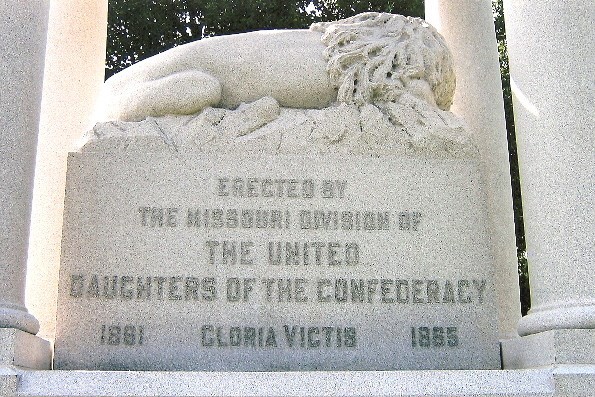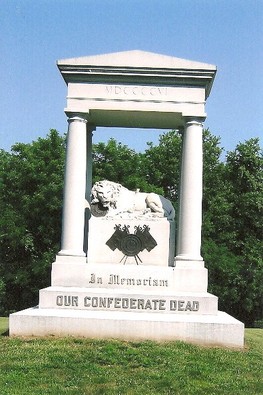Lion of Lucerne/Confederate Memorial State Historic Site
Introduction
Text-to-speech Audio
The Lion of Lucerne stands guard over nearly 800 Confederate veterans in the cemetery located on the grounds of the Confederate Memorial State Historic Site, and what was once a home for men who had served during the Civil War in Missouri, and other Southern states. The statue located here in Missouri was erected by the Missouri Division of the Daughters of the Confederacy in 1906. The Missouri Division of the UDC was also able to raise $5,000 for the erection of the statue in a campaign to beautify the home and they hired Kansas City sculptor M. H. Rice to create their replica of the danish sculptor, Bertel Thorvalsden’s Lion of Lucerne, which they embellished with Confederate iconography.
Images


Backstory and Context
Text-to-speech Audio
The Lion of Lucerne is nearly an exact copy of another statue that had been erected in Switzerland to honor the Swiss Guard who had given their lives protecting the King during the French Revolution, the original statue was meant to commemorate the soldiers’ bravery and commitment to service even to the point of making the ultimate sacrifice. The Daughters of the Confederacy probably meant to imply that the men who had served in the Confederacy had made similar sacrifices as the Swiss Guard who had given their lives for what they believed was a just cause. The Daughters of the Confederacy had also chosen to have the following inscription included on their statue: “In Memoriam our Confederate Dead”, the date it had been erected MDCCCVI (1906), “Erected by a division of the Daughters of the Confederacy”, “1861 Gloria Victus 1865”, which means “glory to the vanquished”, and they also included a insignia of Robert E. Lee riding his horse, and another of the Confederate insignia and wreath. All of these additions were meant to solidify that this was a memorial to the men who had given their lives to the Confederate States of America.
In recent years there have been cries surrounding the erection and upkeep of Confederate monuments and monuments made in memorial of the Confederacy, like the Lion of Lucerne. Both the statue and the entire historical site has been called into question. According to a news article in the Columbia Missourian, there have been calls to rename the site in light of the racial violence taking place around the country, and the decision to remove other confederate monuments in other cities and states. There has also been confusion surrounding whether or not the Confederate flag has been flown on the site that has caused further controversy. The site plans to make no moves in changing the name due to the history they are preserving, and the fact that the site was not directly involved in the Civil War, but was born in the aftermath of the War. The site’s website also clarifies that while there are educational signs surrounding the battle flags of the Confederacy displayed at the site, there has not been a Confederate flag flown there since its inception into the Missouri State Park system. Other sources claim that the Confederate battle flag was reserved for special occasions like funerals because the decision had been made that it would not be tasteful to fly the Confederate flag.
There have been recent calls for the removal of monuments that memorialize the Confederacy or Confederate veterans across the nation, and the Lion of Lucerne and the surrounding memorial historic site have also been met with controversy, yet the site and the sculpture still stand today.
Missouri and its residents had unique experiences during and after the Civil War. Although Missouri had been a slave state, they never officially joined the Confederacy and in fact, chose distinctly to stay in the Union in 1861 when other states had made the decision to depart. Missouri still had a considerable number of residents that identified more with the Confederacy than the Union, thus Missouri had a sort of identity crisis throughout the war and after. While the state was never officially part of the Confederacy many men from Missouri chose to fight for the Southern Cause, and lay down their lives. After the war ended, like most members of the Confederacy, Confederate Missourians were not willing to accept the loss, and chose instead to lean into the Lost Cause narrative that still exists today. The Lost Cause had interesting effects in Missouri. Missouri couldn’t claim to be fully Confederate like deeply southern states, or even other border states. Missouri seemed to have a foot in the Confederacy and a foot in the Union. Even with this split identity, many Missourians leaned fully into the Lost Cause, largely romanticizing the Civil War and the way of life that the Confederacy was ultimately fighting for. Organizations were also born to reinforce the Lost Cause mythology. Organizations like the Daughters of the Confederacy and Ex-Confederate Association. These types of organizations would make it their missions to spread the Lost Cause Mythology, like providing misinformation about what took place during the Civil War and putting up Confederate monuments like the Lion of Lucerne in what was once the Confederate Home of Missouri, and is now the Confederate Memorial State Historic Site. Organizations like these are also why the Lost Cause Mythology seems to live on and monuments like these are still in their original locations, because even to this day these organizations exist to protect them.
The Lion of Lucerne located at the Confederate State Memorial Site in Higginsville, Missouri provides an interesting view into the way we choose to remember and honor our veterans. Through the Lost Cause ideology, the Daughters of Confederacy were raising Confederate monuments across the country, and Higginsville Missouri wouldn’t be left untouched. The statue still stands even through years of controversy, and while other monuments across the state and country have come down.
Sources
Boester, Seth. “Missouri’s largest Confederate memorial has drawn little controversy.” Columbia Missourian, 25 November 2018,
- https://www.columbiamissourian.com/news/state_news/missouris-largest-confederate-memorial-has-drawn-little-controversy/article_5e675b6c-cb1c-11e8-a9b7-7bc60dc30888.html. Accessed 5 October 2023
Fluker, Amy Laurel. Commonwealth of Compromise : Civil War Commemoration in Missouri. University of Missouri, 2020. EBSCOhost,
- search.ebscohost.com/login.aspx?direct=true&AuthType=sso&db=nlebk&AN=2462649&scope=site.
“General Information.” Missouri State Parks,
- https://mostateparks.com/page/54952/general-information Accessed 5 October 2023.
Kofoed, Kira. “Dying Lion (The Lucerne Lion) - a national-political monument with built-in controversy.” The Thorvaldsens Museum Archives, 2013, Accessed 14 Nov 2023.
- https://arkivet.thorvaldsensmuseum.dk/articles/dying-lion-the-lucerne-lion#:~:text=The%20lion%20was%20to%20symbolize,compromised%20on%20a%20dying%20lion.
“National Register of Historic Places Inventory Nomination Form.” United States Department of Interior National Park Service,
- https://mostateparks.com/sites/mostateparks/files/Confederate%20Chapel%2C%20Cemetery%20and%20Cottage.pdf
“‘Southern cause’? Missouri’s Confederate memorial skips over the evils of slavery.” Kansas City Star, 9 October 2020,
- https://www.kansascity.com/opinion/editorials/article246331005.html. Accessed 5 October 2023.
YoSam. “The Lion of Lucerne.” Waymarking. Accessed 4 December 2023.
https://www.waymarking.com/waymarks/wm4W18_Lion_of_Lucerne_Higginsville_MO
I don’t know if that last one was cited properly.
